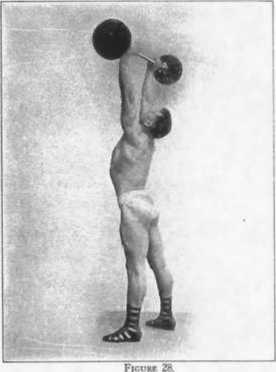milo 01 21


Regular Exerci»e No. 15
For ihc dcvcIopment ot iriceps, dcltoids. and smali ot the back.
Use 15 pounds morc (lian in Regular Excrtise No. 1.
Lift tlić beli to the shoulders as explaincd in Regular Exercise No. 4.
Now that you havc tląc beli in posi-tiou at thc chcst, stand with fcct aboui 12 inchca apart, and left foot slightly advanccd. i,usli thc beli upwards as in position Figurę 27 until it reaches tuli arm‘s length above thc head, as in Figurę No. 28. Lowcr thc beli slowly to thc chcst, and push it up again 5 times in all.
As you push the beli up front the chcst, you are allowcd to lean a littlc bil back front the waist, as in Figurę No. 27. As thc beli goes up. and as it comcs down again, you must kecp your ga/c fastened on the center of thc handle bar betwccn thc ltatids.
Every time a beli goes aloft you must watch it, because if you kecp your gazę fastened on it, your body will automaticnlly balance itself, and there will bc no danger ot strata. You must always obseryc this rule, evcn when there are pcople watching you. When a beginner first starts to lift, ho is apt t<» cali a friend in to watch Itint, and when hc makes a two-arm press hc is vcry likcly to look at the friend to sec what im-pression hc is making on him, instead of watching the beli, and this mny cause thc lifter to łase his balance.
Figurę No. 29 is a variation of this two-arm press. and is known as thc two-arm MiUtary Press. Noticc the lifter is standing with his hccls together, and is holding his body pcrfecUy straight. This makes thc lift much morc difłtcull, and, thereforc, l adviae my pupils lo adnpt posi tion Figurę No. 27, with thc fcct apart.
Figurę No. 30 shows the WRONG WAY of pressing .the beli aloft. Merc thc pupil has allowcd his legs to bend at the knees, and is leaning back much too far. and is "fighting" the beli If evor you find that thc weight of the beli forccs you into this position, it is a sign that the heli is too hcavy, and you should reduce it by five or ten pounds.
(Revicw: You bend the legs at thc knees, and Ican the body forward as you puli the beli to the shoulder; after you puli it to thc shoulder, THEN you stand with thc legs perfectly straight. and push the heli up and down scvcral times. You do NOT Iower thc beli to thc ground after each push. You onltr Iower it untd the bar is about opposite thc ćhin, and then you push it up again.)
Incrcasc 1 repetition cvery third day, until you reach 10 repetitions; then inerease the weight of
thc beli 10 pounds, and start again at 5 repeti tions, etc., etc.
Although we mention that Figurę No. 30 shows thc incorrect method of performing this particular cxercisc, ncvcrthcless it is the correct way to press a beli in an cntircly different lift, known as the Two-Arm Push or Two-Arm Continental Press. This lift will be fully describcd in the Third Coursc, and should not bc attempted previously.
Of Importance to You
We havc purposcly dclayed thc fol lowing advicc until thc last for various rcasons. the main one heing that on rcading it you will not bceomc con-fuscd with any of the former advice, for it will bc scen that thc following lines henr a conlradictory statement in somc cases, morc particularly on thc amount of weight you should use, and tlić cxact number of repetitions, for this rcason. When a pupil commcnccs his training, it is jiossible for us to advisc just thc amount of weight to use, and how many moyements to make with cach cxcr cise for at least a period of nincty days. After that length of time has passed. thc pupil will

Pagc 21
Wyszukiwarka
Podobne podstrony:
68429 milo 01 12 REGULAR EXEKCISE NO. S Pagc 12 flU- »£ 10 Figuro II For Dc««loping Grri! Drptk of t
milo 01 20 EXERCIS£ NO. 13 For N«k Dev«?lopment Stand crcct. holding the bar beli with the overgrip.
milo 01 19 REGULAR KXF.RCI5F. NO. II G»a«ral Ex*rcu« lor tho Bark and L*f■ I.ojd the kcttlc bdl with
milo 01 05 PRELIMINARY EXERC15£ NO. I FlCURE A To D«»elop the Muiel*» of the Abdomen PRELIMINARY F.K
milo 01 07 RECULAR EXERCISES Tbcre arc scveral dctails of this exercisc which arc important. Somc pu
milo 01 05 PRELIMINARY EXERC15£ NO. I FlCURE A To D«»elop the Muiel*» of the Abdomen PRELIMINARY F.K
27801 Ittman 35 PWYSICALCULTURE ANO BREATHING. 35 Exercise No. 15. Stand erect. Grasp the riglit arm
75600 milo 01 24 thrce workouta per w cek, muking one or iwo with weiglihę. and iwo or one with anyt
więcej podobnych podstron